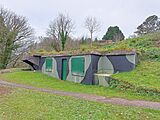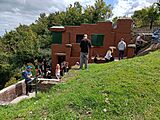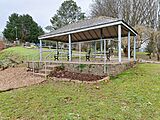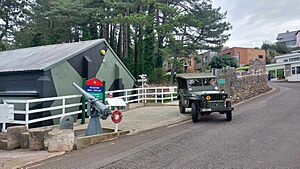Brixham Battery facts for kids
Brixham Battery and Battery Gardens are a cool open space right by the sea in Brixham, Devon. People have watched exciting Brixham trawler races from here for a long time.
This 14-acre site, called Battery Gardens, was first used as a "battery" way back in 1586. This was during a war between England and Spain. A battery is a place where big guns are set up to defend an area.
The Brixham Battery wasn't always armed, but it was used during the American War of Independence in the 1780s. It was also active during the Napoleonic War against France in the early 1800s. Later, in the 1870s, the Coast Guard used it for gun practice.
Most of what you see at the Battery today was built quickly in 1940. This was after the British army had to leave Dunkirk during World War II.
Out of 116 emergency batteries built across Britain in 1940, only seven are left. Brixham Battery is the most complete one! It's now a special historical site, protected by English Heritage.
Contents
What is Brixham Battery?
In military terms, a "battery" means a group of big guns and the soldiers who operate them. During World War II, coastal defence batteries like Brixham had two main types of guns. They had large guns to stop ships and anti-aircraft guns to shoot down enemy planes. Brixham also had extra guns to protect the harbour.
About 100 officers and soldiers worked at the Battery. At first, soldiers from the Royal Artillery manned it. Later, as the threat of invasion lessened, members of the Home Guard took over. These were local volunteers who protected their communities.
A Look Back: History of the Battery
Early Days: 1776 to 1890
We know that a gun platform was first set up here in 1586. It was built to protect against attacks from Spain. This early defence was kept until 1664.
From 1776 to 1890, the battery had many names, like Furzham and Fishcombe Point. In the late 1700s, Brixham was a very important port for the Royal Navy. It was especially vital during the American Civil War.
When France and Spain joined America in the war, Britain decided to protect its naval ports. Brixham was one of these important places.
Battery Gardens became the most western battery, guarding the harbour. Local soldiers prepared the gun positions. Big 24-pounder guns arrived in May 1780. The land was taken for military use, and the owners were paid for it in 1783.
When wars with France started again, the land was bought, and guns were brought back. They were removed again when the wars ended. The battery was still a military site in 1862. It was manned by local volunteer artillery soldiers.
In 1891, a powerful 64-pounder cannon was at Furzham. This gun was mounted on special tracks. It was placed near where an earlier gun had been many years before.
World War II: 1940 to 1945
During World War II, Brixham Battery had a very important job. Along with a similar battery in Torquay at Corbyn Head, it protected all the nearby beaches. These beaches, like Paignton and Goodrington, would have been perfect for enemy landings.
The Corbyn Head battery covered targets inside the bay. Brixham Battery could reach enemy ships further out in Lyme Bay. Besides the large guns, the batteries had anti-aircraft weapons. They also had a 6-pounder Hotchkiss gun to defend the harbour.
Brixham Battery's anti-aircraft defences included a 37 mm gun and 40mm Bofors guns. These were used to shoot down enemy planes.

Brixham Battery was one of many along the South Coast. Another strong battery was at Froward Point, near Kingswear. This was called Brownstone Battery. It was built in 1942 and had powerful 6-inch guns. Its job was to stop enemy landing craft from reaching beaches like Slapton Sands.
You can still see parts of Brownstone Battery today. These include gun beds, the observation post, and searchlight positions. The National Trust now protects them. The observation post is used by the National Coastwatch Institution, where volunteers watch for dangers at sea.
In 1940, during World War II, the Brixham site was first manned by the Royal Artillery. Later, local men from the Home Guard joined them. These local volunteers were well-trained. They could even man the Battery on their own if needed. Their skills were often praised by military leaders.
The Battery's large 4.7-inch guns were never fired at enemy ships. German E-boats (fast attack boats) sometimes entered the bay. However, the guns were not used. This was to keep the Battery's exact location a secret from the enemy. Usually, the Royal Navy would handle enemy vessels.
However, the anti-aircraft guns at Brixham Battery were often in action. They fired at enemy planes that attacked Brixham harbour and ships in the Bay. These planes included Messerschmitt Bf 109s and Focke-Wulf Fw 190s. They carried bombs weighing up to 1000 pounds.
Explore More: The Museum
The Brixham Battery Heritage Group started in 1999. This group works to share the history of Brixham Battery. They also teach people about the local environment, plants, and animals.
Volunteers have helped expand the on-site education centre. It's now known as the Brixham Battery Heritage Museum. It's a great place to learn more about this important historical site.






